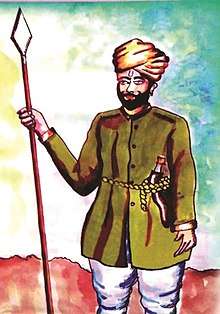Jasrath Khokhar
Jasrath Khokhar was the chief of the Khokhars during 1420–1442.[4] He was known for ruling the Punjab region, Jammu, Haryana, Himachal Pradesh and parts of Khyber Pakhtunkhwa. His campaigns also included Delhi.
| Jasrath Khokhar | |||||
|---|---|---|---|---|---|
 | |||||
| Khokhar King | |||||
| Reign | c. 1420 – 1442 [1] | ||||
| Predecessor | Shaikha Khokhar | ||||
| Born | Late 14th century Sialkot, Punjab Region (Nowadays Punjab, Pakistan) | ||||
| Died | c. 1442 | ||||
| |||||
| Father | Shaikha Khokhar | ||||
| Religion | Islam[2] [3] | ||||
Early life
Jasrath Khokhar was born to Khokhar royalty to Raja Shaikha Khokhar. In one of his father's battles, he was captured by Timurid Empire and was held prisoner in Samarkand. After the death of Taimur, he managed to escape prison.[5]
Rise to Power
After the death of Raja Shaikha Khokhar, Jasrath was crowned the chief of the Khokhar chiefdom. The following year, a civil war erupts in Kashmir between Zain-ul-Abidin and Ali Shah. Zain-ul-Abdin allies himself with Jasrath Khokhar, against Ali Shah. With the help of Jasrath Khokhar, defeats Ali Shah and Zain-ul-Abidin retains the title of ruler of the Shah Mir Dynasty. Jasrath Khokhar was then awarded with the Jammu region.[6] Another ruler, named Rai Bhim from the Jammu region also unites with Ali Shah, against the Khokhars and the ruler of the Shah Mir Dynasty. Rai Bhim and Ali Shah were then killed in battle against Jasrath.[7] After these remarkable victories, Jasrath then set eyes on the throne of Delhi. He then takes over Lahore, the same year, 1421.[8]
Campaigns
After securing the northern Punjab Region and parts of Khyber Pakhtunkhwa, Jasrath Khokhar marches against Multan in 1431.[9] The advancing on Multan, sets his eyes on the Delhi Sultanate. The same year he battles against the Delhi Sultanate and conquers Jullundar, Gurdaspur, Ludhiana and parts of Himachal Pradesh. He then finally takes over Delhi in 1431. But later on September of 1432, he is droven out of Delhi by Mubarak Shah. The Sultan still lost many of his territories under the hands of Jasrath Khokhar. Jasrath still continued fight battles against the Delhi Sultanate.[10]
Notes
- Elliot & Dowson (1872), Chapter XXIX Tabakát-i Bábarí, of Shaikh Zain.
- Khan, M.A. "Islamic Jihad: A Legacy of Forced Conversion, Imperialism, and Slavery". Google Books. iUniverse, Inc. Retrieved 11 June 2019.
- Encyclopaedia of Untouchables Ancient, Medieval and Modern, By Raj Kumar, Kalpaz Publ., Page 280
- Elliot & Dowson (1872), Chapter XXIII Bauzatu-s Safá, of Mírkhond, Chapter XXIV Khulátatu-l Akhbár, of Khondamír.
- Lal (1995).
- Elliot & Dowson (1872), Chapter XXI Tárikh-i Mubárak Sháhí, of Yahyá bin Ahmad.
- Kumar (2008), p. 322.
- Gaṇeśadāsa (1991), pp. 109–110,121.
- Civil and Military Gazette Press (1902), p. 43.
- Charak (1985).
References
- Charak, Sukh Dev Singh (1985). A Short History of Jammu Raj: From Earliest Times to 1846 A.D. Ajaya Prakashan.CS1 maint: ref=harv (link)
- Elliot, Henry Miers; Dowson, John (1872). The History of India, as Told by Its Own Historians: The Muhammadan Period (pdf). 4. Trübner.CS1 maint: ref=harv (link)
- Gaṇeśadāsa, Baḍehra. Billawaria, Anita K (ed.). Rājdarshani: a Persian history of north-western India from earliest times to A.D. 1847. Translated by Charak, Sukh Dev Singh. Jay Kay Book House.CS1 maint: ref=harv (link)
- Gazetteer of the Multan District. Punjab (India): Civil and Military Gazette Press. 1902.CS1 maint: ref=harv (link)
- Kumar, R (2008). Encyclopaedia of Untouchables Ancient, Medieval and Modern. Kalpaz. p. 322. ISBN 978-8178356648. Retrieved 2019-02-03.CS1 maint: ref=harv (link)
- Lal, K S (1995). Growth of scheduled tribes and castes in medieval India. Aditya Prakashan. p. 75. ISBN 978-8186471036. Retrieved 2019-02-03.CS1 maint: ref=harv (link)